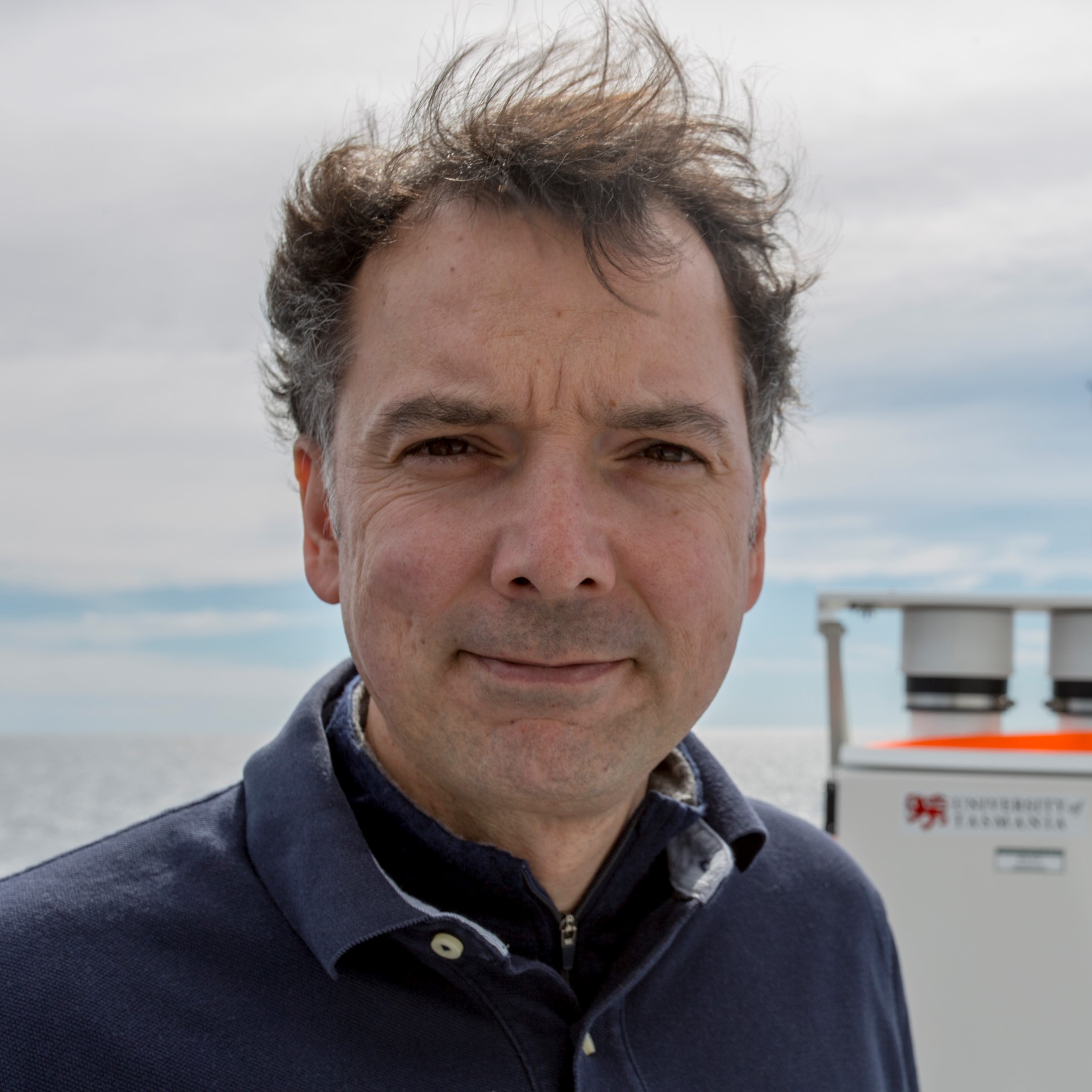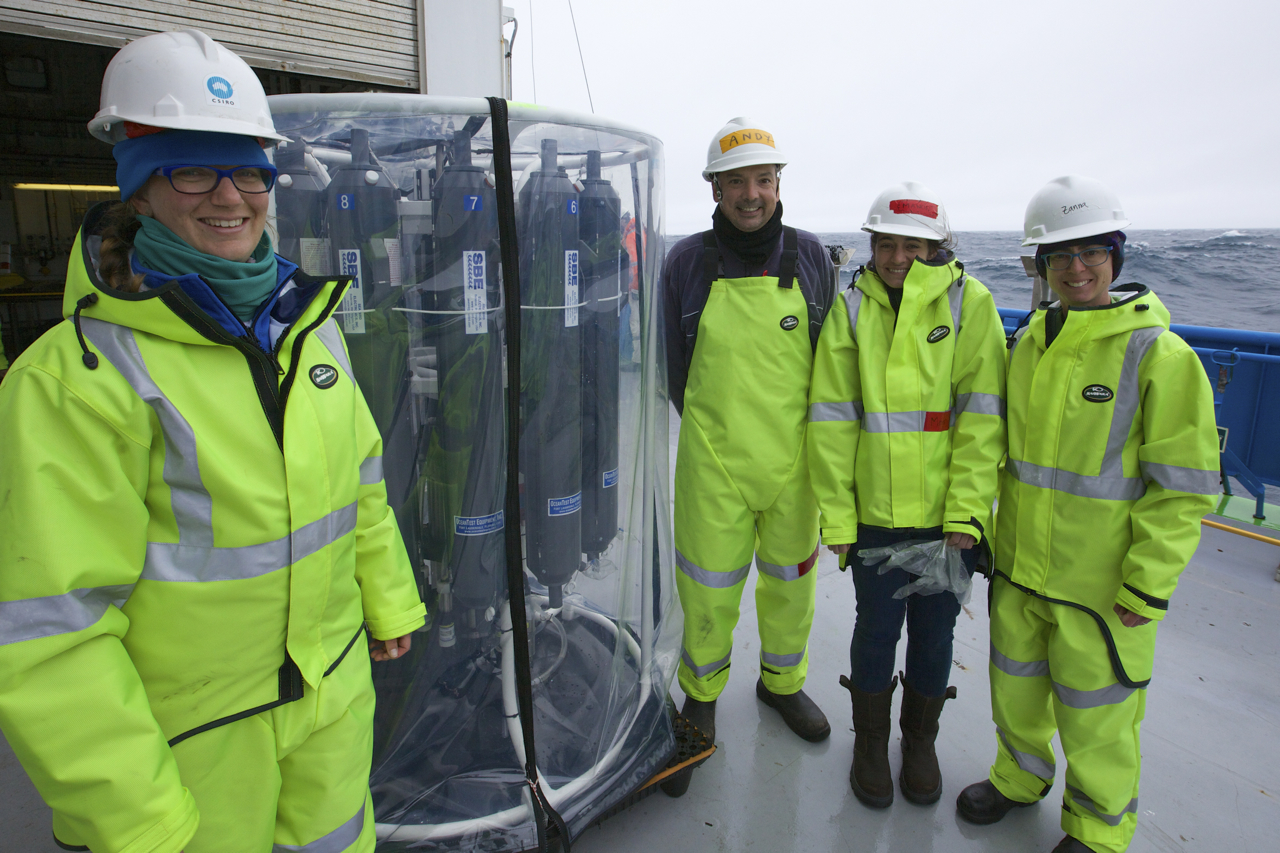 Understanding our anaemic oceans
Understanding our anaemic oceans
Oceans play a vital role in Earth's climate through the control of atmospheric carbon dioxide. An important component of this system is the iron cycle, in which iron-rich dust is transported from the land via atmosphere to ocean. Iron is a key micronutrient for marine phytoplankton, the scarcity of which limits essential biogeochemical processes and ocean fertility.
Project name
Natural iron fertilisation: linking terrestrial dust, marine biogeochemistry and climate
Principal Investigator
Institution
Institute for Marine and Antarctic Studies (IMAS)
Project duration
August 2016 - present
Overview
The project is an integrated oceanographic and atmospheric observational program for trace elements in oceans around Australia. The project seeks to collect critical information on iron supplied from atmospheric dust for ocean productivity and marine ecosystem health, providing the science for predicting a key factor in the future impact of the oceans on climate.
Project aims
Iron is a key micronutrient for marine phytoplankton, the scarcity of which controls essential biogeochemical processes. This project will facilitate an integrated ship-based atmospheric observational program for trace elements in oceans around Australia. During the voyages, researchers will sample and conduct experiments on atmospheric particles containing terrestrial dust, bushfire smoke and anthropogenic emissions that are transported from Australia to its surrounding oceans.
 The project will quantify the importance of iron-rich dust and bushfire smoke from Australia for marine biogeochemistry, ocean health and climate. The outcomes will provide a scientific basis for managing the complex role of iron in sustaining marine ecosystem biodiversity and for informing government policy on ocean fertilisation as a carbon mitigation strategy.
The project will quantify the importance of iron-rich dust and bushfire smoke from Australia for marine biogeochemistry, ocean health and climate. The outcomes will provide a scientific basis for managing the complex role of iron in sustaining marine ecosystem biodiversity and for informing government policy on ocean fertilisation as a carbon mitigation strategy.
Project results
The project has provided five significant outcomes that have advanced the disciplines of chemical oceanography and atmospheric chemistry, specifically the marine biogeochemistry of trace elements:
- Establishment of an aerosol monitoring program for trace elements on Australia’s primary ocean research vessel.
- Establishment of land-based monitoring sites for bushfire and dust emissions around Australia.
- Development of a quantitative understanding of atmospheric deposition for marine biogeochemical cycles in the major biogeographic ocean provinces surrounding Australia.
- Provision of new observations of the geochemical nature, solubility and biological availability of atmospherically delivered trace elements, and how these factors vary with long‐range transport and cycling.
- Optimisation of model predictions of the land–atmosphere–ocean iron‐dust cycle using new parameterisations normalised for contemporary southern hemisphere conditions.
The project has identified that atmospheric particles containing iron that enter the ocean from the west coast of Australia were mostly dust-sourced, with relatively high iron concentrations and low iron solubilities (<5%). Atmospheric particles entering the ocean from the east coast were from mixed sources and have relatively lower iron concentrations but higher iron solubilities (13%), with solubility increased due to interactions with man-made pollutants in the atmosphere.
Surprisingly, materials containing iron found in the atmosphere in northern Australia had relatively high iron solubilities (>20%) and this was associated with emissions (smoke) from bushfires – either directly or through reactions in the atmosphere – in tropical regions. In northern Australia, emissions from bushfires accounted for nearly 50% of the total soluble iron entering the ocean from the land.
Project voyages
The project commenced in August 2016 and has been included on the following voyages:
2025: IN2025_V02
2023: IN2023_V01
2021: IN2021_V02
2019: IN2019_V02
2018: IN2018_V04, IN2018_V02, IN2018_V01
2017: IN2017_V05, IN2017_T01
2016: IN2016_V04, IN2016_T02, IN2016_V01
Voyage summaries, publications and project outcomes are available on each voyage summary page.
Understanding our anaemic oceans
Oceans play a vital role in Earth's climate through the control of atmospheric carbon dioxide. An important component of this system is the iron cycle, in which iron-rich dust is transported from the land via atmosphere to ocean. Iron is a key micronutrient for marine phytoplankton, the scarcity of which limits essential biogeochemical processes and ocean fertility.
Project name
Natural iron fertilisation: linking terrestrial dust, marine biogeochemistry and climate
Principal Investigator
Institution
Institute for Marine and Antarctic Studies (IMAS)
Project duration
August 2016 - present
Overview
The project is an integrated oceanographic and atmospheric observational program for trace elements in oceans around Australia. The project seeks to collect critical information on iron supplied from atmospheric dust for ocean productivity and marine ecosystem health, providing the science for predicting a key factor in the future impact of the oceans on climate.
Project aims
Iron is a key micronutrient for marine phytoplankton, the scarcity of which controls essential biogeochemical processes. This project will facilitate an integrated ship-based atmospheric observational program for trace elements in oceans around Australia. During the voyages, researchers will sample and conduct experiments on atmospheric particles containing terrestrial dust, bushfire smoke and anthropogenic emissions that are transported from Australia to its surrounding oceans.
The project will quantify the importance of iron-rich dust and bushfire smoke from Australia for marine biogeochemistry, ocean health and climate. The outcomes will provide a scientific basis for managing the complex role of iron in sustaining marine ecosystem biodiversity and for informing government policy on ocean fertilisation as a carbon mitigation strategy.
Project results
The project has provided five significant outcomes that have advanced the disciplines of chemical oceanography and atmospheric chemistry, specifically the marine biogeochemistry of trace elements:
- Establishment of an aerosol monitoring program for trace elements on Australia’s primary ocean research vessel.
- Establishment of land-based monitoring sites for bushfire and dust emissions around Australia.
- Development of a quantitative understanding of atmospheric deposition for marine biogeochemical cycles in the major biogeographic ocean provinces surrounding Australia.
- Provision of new observations of the geochemical nature, solubility and biological availability of atmospherically delivered trace elements, and how these factors vary with long‐range transport and cycling.
- Optimisation of model predictions of the land–atmosphere–ocean iron‐dust cycle using new parameterisations normalised for contemporary southern hemisphere conditions.
The project has identified that atmospheric particles containing iron that enter the ocean from the west coast of Australia were mostly dust-sourced, with relatively high iron concentrations and low iron solubilities (<5%). Atmospheric particles entering the ocean from the east coast were from mixed sources and have relatively lower iron concentrations but higher iron solubilities (13%), with solubility increased due to interactions with man-made pollutants in the atmosphere.
Surprisingly, materials containing iron found in the atmosphere in northern Australia had relatively high iron solubilities (>20%) and this was associated with emissions (smoke) from bushfires – either directly or through reactions in the atmosphere – in tropical regions. In northern Australia, emissions from bushfires accounted for nearly 50% of the total soluble iron entering the ocean from the land.
Project voyages
The project commenced in August 2016 and has been included on the following voyages:
2025: IN2025_V02
2023: IN2023_V01
2021: IN2021_V02
2019: IN2019_V02
2018: IN2018_V04, IN2018_V02, IN2018_V01
2017: IN2017_V05, IN2017_T01
2016: IN2016_V04, IN2016_T02, IN2016_V01
Voyage summaries, publications and project outcomes are available on each voyage summary page.
